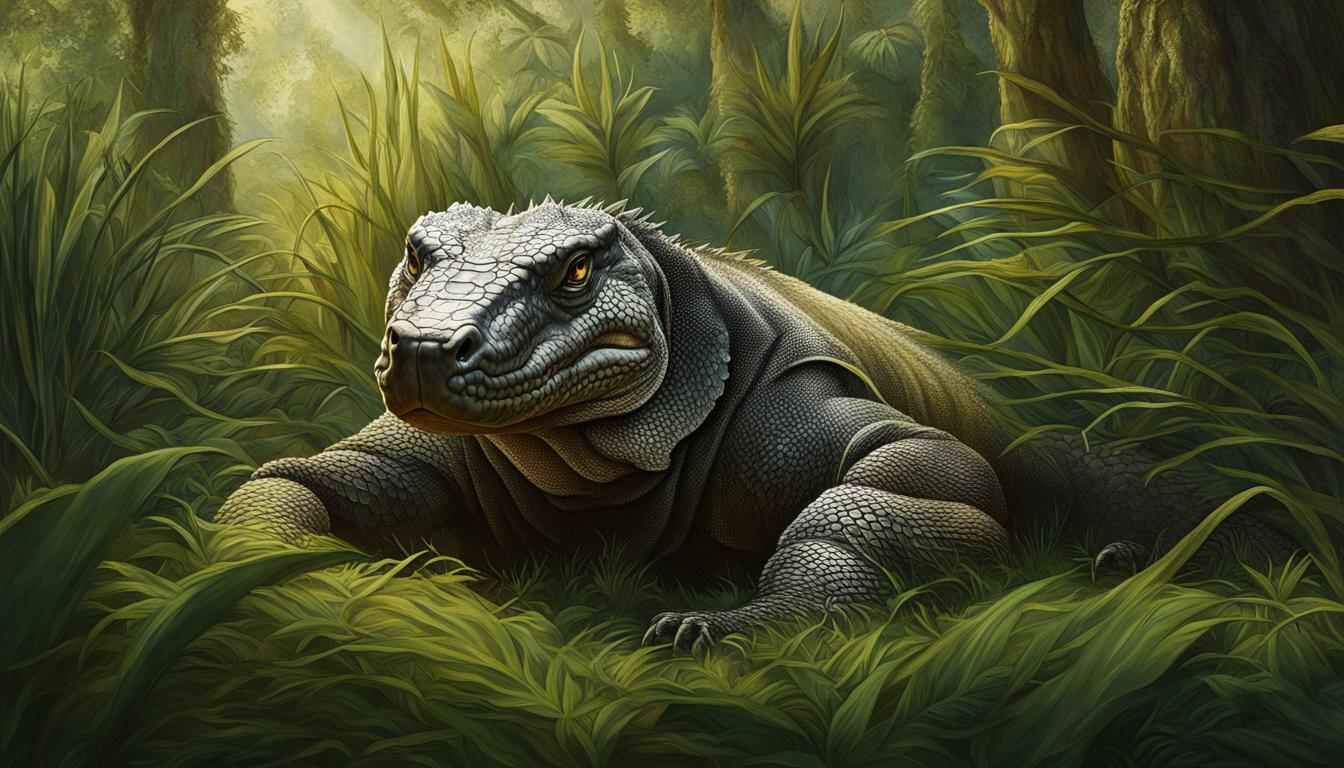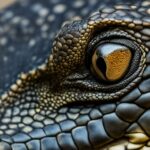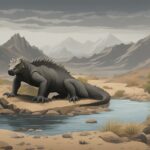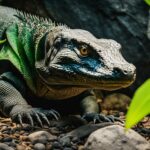Welcome to our article on the lifespan of Komodo dragons. These incredible reptiles, scientifically known as Varanus komodoensis, are the largest lizards on Earth. Found in Indonesia’s Lesser Sunda Islands, Komodo dragons have an average lifespan of up to 30 years in the wild. Prepare to be amazed by their size, strength, and unique adaptations.
At a staggering length of up to 10 feet and weighing around 330 pounds, Komodo dragons are truly a sight to behold. Their impressive size is just one of the many fascinating aspects of these reptiles. In this article, we will delve into their habitat, feeding habits, and the threats they face in their natural environment. Additionally, we will explore the conservation efforts in place to protect these remarkable creatures.
So, join us on this journey as we uncover the wonders of Komodo dragons and gain a deeper understanding of their average lifespan and the factors that contribute to their survival in the wild.
Overview of the Komodo Dragon
The Komodo dragon, scientifically known as Varanus komodoensis, is a fascinating reptile species that can be found in Indonesia’s Lesser Sunda Islands. These reptiles are known for their impressive size, with adults growing up to 10 feet in length and weighing around 330 pounds.
Komodo dragons have long, flat heads, rounded snouts, and muscular bodies. Their powerful legs and sharp claws make them dominant predators in their habitat. They have the ability to catch a variety of prey, including deer, pigs, smaller dragons, and even large water buffalo. These carnivorous reptiles rely on their keen sense of smell to locate food, with their diet mainly consisting of carrion.
Key Traits:
- Long, flat heads and rounded snouts
- Muscular bodies and powerful legs
- Sharp claws for catching prey
- Keen sense of smell for locating food
- Diet consisting of carrion
One of the unique adaptations of Komodo dragons is their venomous bite. Their saliva contains various bacteria and toxins that can incapacitate their prey. They also have venom glands in their mouths, which contain toxins that lower blood pressure, prevent clotting, and induce shock. This venom helps them subdue their prey and speed up the process of blood loss.
| Unique Traits | Description |
|---|---|
| Venomous Bite | Saliva contains bacteria and toxins that incapacitate prey |
| Powerful Presence | Massive size and bone deposits under the skin provide protection |
| Mammal-like Metabolism | Achieve bursts of speed and endurance during hunting |
With their remarkable size, unique adaptations, and dominance as predators, Komodo dragons are truly fascinating creatures that play a crucial role in their ecosystem.
Habitat and Reproduction
The Komodo dragon thrives in the tropical forests of Indonesia’s Lesser Sunda Islands. This unique habitat provides the perfect environment for these fascinating creatures to live and reproduce. Komodo dragons are highly adapted to the harsh climate of their home range, which includes a mix of savannah, monsoon forest, and deciduous forest.
When it comes to reproduction, female Komodo dragons have an interesting strategy. Once a year, they release a scent in their feces to attract males for mating. This behavior ensures that the females have a higher chance of successfully reproducing. After mating, the female lays about 30 eggs, which she buries in a nest she digs in the earth. The nesting temperature determines the sex of the offspring, with higher temperatures resulting in more females and lower temperatures resulting in more males.
What’s truly remarkable about Komodo dragons is their ability to reproduce asexually through a process called parthenogenesis. This means that a female can lay viable eggs without the need for fertilization from a male. While this form of reproduction is rare among reptiles, it provides an important survival mechanism for the species. Parthenogenesis allows a female to reproduce even in the absence of male dragons, ensuring the continuation of the population.
Table: Komodo Dragon Reproduction
| Reproduction | Details |
|---|---|
| Mating Season | Once a year |
| Egg Laying | Approximately 30 eggs per clutch |
| Nesting Behavior | Females dig a nest in the ground to lay their eggs |
| Sex Determination | Temperature-dependent (higher temperatures result in females, lower temperatures result in males) |
| Parthenogenesis | Asexual reproduction without fertilization |
The habitat and reproduction behavior of Komodo dragons are crucial aspects of their survival. By understanding and protecting their unique habitat, we can ensure the continued existence of these majestic creatures.
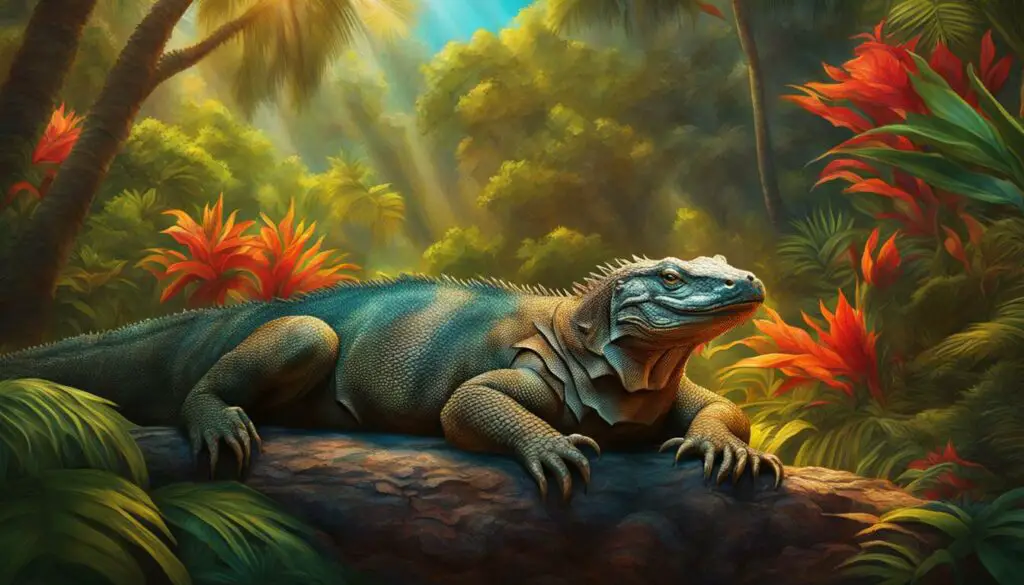
Feeding Habits
Komodo dragons are fascinating creatures known for their versatile diet and unique hunting methods. These mighty reptiles are skilled opportunistic feeders, capable of devouring a wide variety of prey. Their feeding habits play a crucial role in their survival and ecosystem balance.
Adaptations for Hunting and Feeding
Komodo dragons have evolved several adaptations that make them formidable predators. Their large size and powerful legs enable them to chase down and overpower prey. With their long, forked tongues and acute sense of smell, they can detect carrion from great distances, allowing them to scavenge for food when hunting is scarce.
When it comes to hunting live prey, Komodo dragons employ both stealth and patience. They use their excellent camouflage to blend into their surroundings, remaining unseen by unsuspecting prey. Once in striking range, they pounce with lightning speed, delivering a swift and powerful bite.
Their serrated teeth and strong jaws allow them to tear flesh into manageable pieces, making it easier to consume. Additionally, Komodo dragons possess venom glands in their mouths, which inject toxins into their prey. The venom serves to immobilize the prey, making it easier for the dragon to overpower and consume.
https://www.youtube.com/watch?v=LxMG81p0k1A
Diverse Diet
Komodo dragons are known to have a diverse diet, ranging from smaller prey like insects and rodents to large mammals such as deer and water buffalo. Their ability to consume such a wide range of prey is due to their powerful digestive systems, which can break down tough bone and fur.
These apex predators are also known for their scavenging behavior. They often rely on their acute sense of smell to locate decaying carcasses, which provide an easy and abundant source of food. This scavenging behavior not only ensures their survival during lean periods but also plays a vital role in the ecosystem by helping to control the spread of disease.
Table: Komodo Dragon Diet
| Predators | Prey |
|---|---|
| Smaller Komodo Dragons | Insects, rodents, smaller reptiles |
| Adult Komodo Dragons | Deer, pigs, monkeys |
| Large Komodo Dragons | Water buffalo, wild boar |
As shown in the table above, the diet of Komodo dragons varies depending on their size and age. This adaptability allows them to thrive in their habitat and fulfill their nutritional needs.
In conclusion, the feeding habits of Komodo dragons showcase their remarkable adaptations and versatility as predators. Their diverse diet, ranging from carrion to large mammals, highlights their crucial role in maintaining the delicate balance of their ecosystem. By understanding and appreciating these feeding habits, we can gain a deeper appreciation for the complexities of nature and the extraordinary abilities of these magnificent reptiles.
Threats to Komodo Dragons
Despite their remarkable adaptability, Komodo dragons face numerous threats that put their survival at risk. These majestic creatures, known for their impressive size and predatory prowess, are now confronting a range of challenges that demand urgent attention from conservationists and policymakers alike.
Loss of Habitat
One of the most significant threats to Komodo dragons is the loss of their natural habitat due to human activities. The clearing of land for agriculture and altered fire regimes have resulted in the destruction of vital forests and ecosystems that these reptiles rely on for survival. As their habitat diminishes, Komodo dragons face increasing competition for resources and a decline in prey availability, which compromises their ability to thrive.
Poaching and Illegal Trade
Poaching poses a grave threat to the Komodo dragon population. These magnificent creatures, prized for their impressive size and unique features, attract illegal trade in their skins and body parts. The demand for these items, fueled by their perceived value, drives poachers to target Komodo dragons and their prey. The relentless pursuit of profit puts immense pressure on these already vulnerable species, pushing them closer to the brink of extinction.
Invasive Species and Inbreeding
The introduction of invasive species disrupts the delicate balance of the ecosystem in which Komodo dragons reside. These new species often outcompete native flora and fauna, further reducing the availability of prey for the dragons. Additionally, the scarcity of females within the population and their reluctance to migrate beyond their home range has led to inbreeding, which poses genetic risks and diminishes the overall resilience of the species.
| Threats | Impact |
|---|---|
| Loss of Habitat | Diminished resources and prey availability |
| Poaching and Illegal Trade | Population decline due to targeted hunting |
| Invasive Species and Inbreeding | Disruption of ecosystem balance and genetic risks |
The comprehensive understanding of these threats is essential for implementing effective conservation strategies to safeguard the future of Komodo dragons. By addressing habitat loss, cracking down on illegal trade, and managing invasive species, we can create an environment where these remarkable reptiles can thrive for generations to come.
Conservation Efforts
The conservation of Komodo dragons is of paramount importance to ensure their long-term survival. Efforts are being made to protect their habitat, raise awareness, and prevent illegal activities that threaten this iconic species.
Protection through Komodo National Park
Indonesia established Komodo National Park in 1980 to safeguard the Komodo dragon and its habitat. Spanning 700 square miles, this protected area serves as a crucial refuge for various species, including the Komodo dragon. The park actively enforces strict regulations to prevent poaching and ensure the preservation of this unique reptile.
Partnerships and collaborations with local communities and conservation organizations also play a vital role in the conservation of Komodo dragons. Engaging with local stakeholders enhances the understanding of the importance of protecting these creatures and encourages sustainable practices that benefit both the wildlife and the communities.
Preventing Illegal Trade
Illegal trade poses a significant threat to Komodo dragons. The commercial trade of live specimens, skins, or other body parts is strictly prohibited under international regulations. By refraining from purchasing products made from their skins or other body parts, individuals can contribute to the conservation efforts and discourage the illegal trade that pushes these magnificent creatures closer to extinction.
Supporting Conservation Organizations and Responsible Tourism
Supporting conservation organizations dedicated to the preservation of Komodo dragons is crucial in securing their future. Programs like the Komodo Survival Program work tirelessly to study, protect, and raise awareness about these remarkable reptiles. Donations, volunteering, or spreading the word about these organizations can make a significant impact.
Visiting Komodo National Park responsibly is another way to contribute to the conservation of Komodo dragons. Following park guidelines, respecting the wildlife, and practicing sustainable tourism ensures that their habitat remains intact and undisturbed.
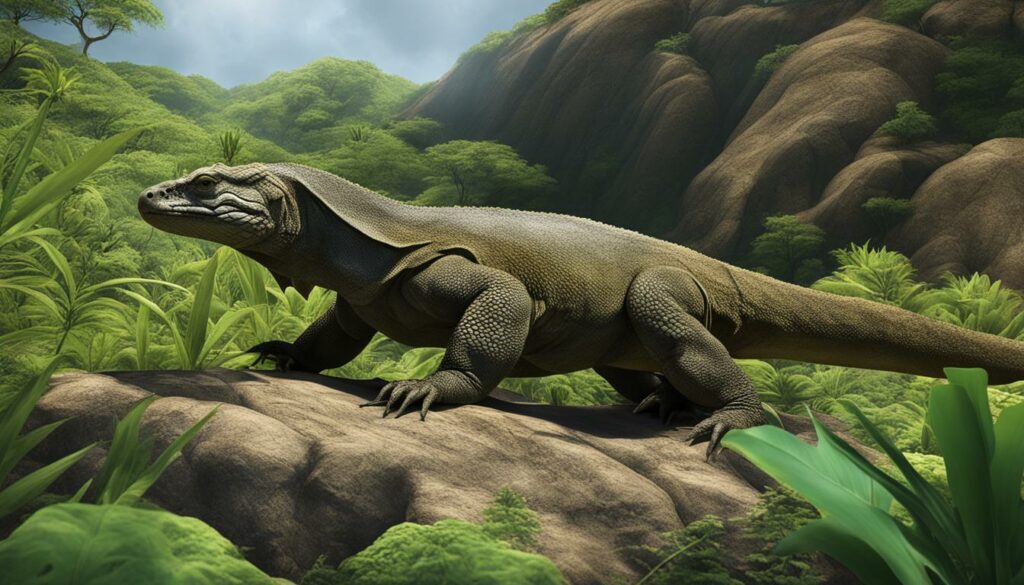
By supporting conservation efforts, we can protect the Komodo dragon and preserve its natural habitat for future generations. Together, we can make a difference and ensure the survival of this iconic species.
Unique Traits of Komodo Dragons
Komodo dragons possess several unique traits that make them fascinating creatures. One of their most remarkable characteristics is their venomous bite. When a Komodo dragon bites its prey, its saliva contains a potent mix of bacteria and toxins that can incapacitate even large animals, allowing the dragon to subdue and devour its meal.
Another distinctive trait of Komodo dragons is their massive size. They can grow up to 10 feet in length and weigh around 330 pounds, making them the largest living lizards in the world. This size, coupled with bone deposits under their skin, provides them with protection and contributes to their powerful presence.
Komodo dragons also have a metabolism similar to that of mammals, which allows them to achieve bursts of speed and endurance during hunting. This unique adaptation gives them an advantage when pursuing prey and enables them to compete with other formidable predators in their natural habitat.
“Komodo dragons possess incredible adaptations that have allowed them to become apex predators in their ecosystem,” says Dr. Jane Carter, a reptile expert. “Their venomous bite, massive size, and mammal-like metabolism make them truly remarkable creatures.”
| Unique Traits of Komodo Dragons | Description |
|---|---|
| Venomous Bite | Their saliva contains bacteria and toxins that can incapacitate their prey. |
| Massive Size | They can grow up to 10 feet in length and weigh around 330 pounds. |
| Mammal-like Metabolism | They have a metabolism similar to that of mammals, allowing bursts of speed and endurance. |
These incredible adaptations and distinctive traits make the Komodo dragon a formidable predator and a truly captivating species in its natural habitat.
Distribution and Status
The Komodo dragon is endemic to Indonesia’s Lesser Sunda Islands, specifically Komodo, Rinca, Flores, Gili Motang, and Padar islands. These islands serve as the primary habitat for this iconic species. Interestingly, the first discovery of Komodo dragons was actually in Australia, where they were believed to have roamed thousands of years ago.
Currently, the population of Komodo dragons is estimated to be around 1,383 mature individuals. However, the distribution of these magnificent creatures is limited, with most populations concentrated in Komodo National Park. The park spans an area of 700 square miles and has been instrumental in the conservation efforts for this endangered species. Unfortunately, the population on the island of Flores is declining due to various threats, including habitat loss and human-animal conflicts.
The International Union for Conservation of Nature (IUCN) lists the Komodo dragon as an endangered species. This designation is due to the limited distribution of the species and the numerous threats they face, such as loss of habitat, poaching, and invasive species. The combination of these factors puts the long-term survival of Komodo dragons at risk.
However, there is hope for the preservation of this remarkable species. With continued conservation efforts, including habitat protection, regulation of trade, and community engagement, we can work towards securing a brighter future for the Komodo dragon. It is essential that we raise awareness and take action to protect these majestic creatures and the unique ecosystem they inhabit.
| Distribution | Status |
|---|---|
| Endemic to Indonesia’s Lesser Sunda Islands | Endangered |
| Distribution Islands: | Total Population: 1,383 mature individuals |
| – Komodo | |
| – Rinca | |
| – Flores | |
| – Gili Motang | |
| – Padar |
Image source: https://seo writing.ai/32_6.png
Conservation Actions for Komodo Dragons
Protecting the Komodo dragon and its habitat requires collective efforts and responsible actions. Here are some conservation actions you can take to contribute to the preservation of this remarkable species:
- Refrain from purchasing products made from Komodo dragon skins or other body parts. The commercial trade of live specimens, skins, or other parts is illegal under international regulations. By abstaining from supporting this trade, you can help reduce the demand for these products and discourage illegal activities.
- Support conservation organizations like the Komodo Survival Program. These organizations work tirelessly to protect Komodo dragons and their habitats, conduct research, raise awareness, and implement conservation initiatives. Your donations and support can make a significant difference in their efforts.
- Visit Komodo National Park responsibly. When visiting this protected area, follow guidelines and regulations set by the park management. Respect the wildlife and their natural habitat, avoid littering, and adhere to designated trails. Responsible tourism can help generate revenue for the park and contribute to conservation efforts.
- Spread awareness. Educate others about the importance of conserving Komodo dragons and their habitats. Share information on social media, participate in community events, and engage in discussions to raise awareness about the challenges these iconic creatures face and the efforts needed for their survival.
By taking these conservation actions, you can play a crucial role in safeguarding the future of Komodo dragons. It is only through collective efforts that we can ensure the long-term survival of this species and preserve the biodiversity of our planet.
| Conservation Actions | Impact |
|---|---|
| Refrain from purchasing products made from Komodo dragon parts | Reduces demand for illegal trade and poaching |
| Support conservation organizations like the Komodo Survival Program | Contributes to research, protection, and awareness campaigns |
| Visit Komodo National Park responsibly | Generates revenue for the park and supports conservation efforts |
| Spread awareness | Increases public knowledge and support for conservation |
Conclusion
In conclusion, the Komodo dragon is a truly remarkable creature, with its impressive size, unique adaptations, and status as the largest living lizard. With an average lifespan of up to 30 years in the wild, these magnificent reptiles have captivated the attention of people around the world.
However, their future is at risk due to various threats such as habitat loss, poaching, and the introduction of invasive species. It is crucial that we take immediate action to protect these endangered species and ensure their long-term survival.
Conservation efforts, such as the establishment of Komodo National Park, have played a significant role in safeguarding their habitat and raising awareness about the importance of conservation. By supporting these initiatives and refraining from purchasing products made from their skins or other body parts, we can make a difference in preserving the Komodo dragon for future generations.
Together, let’s work towards securing a future for these remarkable reptiles in their natural habitat. By promoting awareness, engaging in conservation actions, and respecting their environment, we can help ensure that the Komodo dragon continues to thrive for years to come.
What is the Relationship Between the Lifespan and Size of Komodo Dragons?
The astonishing size of komodo dragons plays a significant role in their lifespan. As the largest lizards on Earth, reaching up to 10 feet in length and weighing over 150 pounds, their size provides numerous advantages. With their immense bodies, they can overpower prey and fend off potential threats, ultimately contributing to their survival and extended lifespan in the wild.
FAQ
How long do Komodo dragons live?
Komodo dragons have an average lifespan of up to 30 years in the wild.
Where can Komodo dragons be found?
Komodo dragons can be found in Indonesia’s Lesser Sunda Islands.
What do Komodo dragons eat?
Komodo dragons are carnivorous and eat a variety of prey, including deer, pigs, smaller dragons, and large water buffalo.
How do Komodo dragons reproduce?
Female Komodo dragons lay eggs, usually burying about 30 of them in the earth. They can also reproduce asexually through parthenogenesis.
Do Komodo dragons have venom?
Yes, Komodo dragons have venom glands in their mouths that contain toxins to subdue prey and speed up blood loss.
What are the threats to Komodo dragons?
Threats to Komodo dragons include habitat loss, poaching, invasive species, and inbreeding.
How can we protect Komodo dragons?
Conservation efforts, such as establishing protected areas like Komodo National Park, raising awareness, and supporting conservation organizations, can protect Komodo dragons and their habitat.
What are the unique traits of Komodo dragons?
Komodo dragons have venomous bites, massive size with bone deposits for protection, and a metabolism similar to mammals.
Where are Komodo dragons found?
Komodo dragons are endemic to Indonesia’s Lesser Sunda Islands but were first discovered in Australia. The current population is estimated to be around 1,383 mature individuals.
How can I contribute to the conservation of Komodo dragons?
To support conservation, refrain from purchasing products made from Komodo dragon parts, abide by regulations against the trade of live specimens or skins, and support conservation organizations and responsible visits to Komodo National Park.

